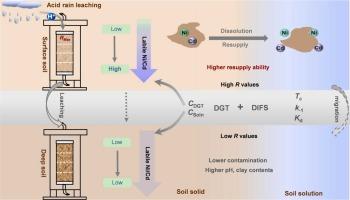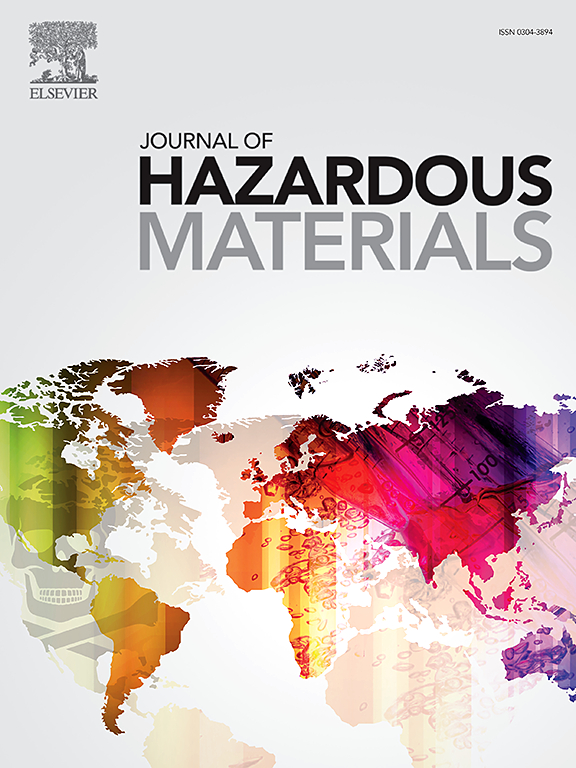Migration and Availability of Ni and Cd in Industrial Soils Under Different Leaching Conditions: Insights from DGT and DIFS Models
IF 12.2
1区 环境科学与生态学
Q1 ENGINEERING, ENVIRONMENTAL
引用次数: 0
Abstract
Rainfall runoff can mobilize heavy metals in industrial soils, posing environmental risks. The mobility and distribution of heavy metals in different industrial soil layers are often overlooked. This study employed dynamic leaching experiments in layered soil columns with DGT (the diffusive gradients in thin films) measurements and DIFS (DGT-induced fluxes in soils and sediments) model to describe the migration, availability, and resupply ability of metals at different depths in surface and deep soil columns of industrial soils. Results showed significantly higher available concentrations (CDGT and CSoln) of Ni and Cd in surface soils compared to deep soils, likely due to the differences in soil physiochemical properties (contamination, pH, and soil texture). Continuous leaching promoted the migration of available Ni and Cd in surface soils. Maximum values of RNi (0.79–0.91) and RCd (0.75–0.80) were observed in the top layer (0–4 cm) of the surface soil, consistent with the trends of RFe. Combined DGT and DIFS model analysis implied higher potential availability and resupply of Ni and Cd in surface soil columns. These findings highlight the importance of considering dynamic leaching effects on heavy metal transport, availability, and release in industrial soils.

不同浸出条件下工业土壤中镍和镉的迁移和可用性:DGT 和 DIFS 模型的启示
降雨径流会迁移工业土壤中的重金属,从而带来环境风险。重金属在不同工业土壤层中的迁移性和分布往往被忽视。本研究采用分层土柱动态浸出实验、DGT(薄膜中的扩散梯度)测量和 DIFS(土壤和沉积物中的 DGT 诱导通量)模型来描述工业土壤表层和深层土柱中不同深度金属的迁移、可用性和再补给能力。结果表明,表层土壤中镍和镉的可用浓度(CDGT 和 CSoln)明显高于深层土壤,这可能是由于土壤理化性质(污染、pH 值和土壤质地)的差异造成的。持续浸出促进了表层土壤中可用镍和镉的迁移。在表层土壤的顶层(0-4 厘米)观察到 RNi(0.79-0.91)和 RCd(0.75-0.80)的最大值,这与 RFe 的趋势一致。DGT 和 DIFS 模型的综合分析表明,表层土柱中镍和镉的潜在供应量和再供应量较高。这些发现强调了考虑工业土壤中重金属迁移、可用性和释放的动态沥滤效应的重要性。
本文章由计算机程序翻译,如有差异,请以英文原文为准。
求助全文
约1分钟内获得全文
求助全文
来源期刊

Journal of Hazardous Materials
工程技术-工程:环境
CiteScore
25.40
自引率
5.90%
发文量
3059
审稿时长
58 days
期刊介绍:
The Journal of Hazardous Materials serves as a global platform for promoting cutting-edge research in the field of Environmental Science and Engineering. Our publication features a wide range of articles, including full-length research papers, review articles, and perspectives, with the aim of enhancing our understanding of the dangers and risks associated with various materials concerning public health and the environment. It is important to note that the term "environmental contaminants" refers specifically to substances that pose hazardous effects through contamination, while excluding those that do not have such impacts on the environment or human health. Moreover, we emphasize the distinction between wastes and hazardous materials in order to provide further clarity on the scope of the journal. We have a keen interest in exploring specific compounds and microbial agents that have adverse effects on the environment.
 求助内容:
求助内容: 应助结果提醒方式:
应助结果提醒方式:


